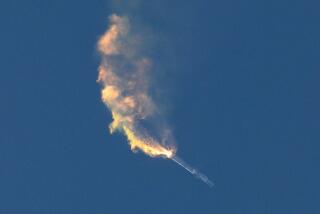Space Junk Could Soon Make Shuttle Missions Too Risky
WASHINGTON — Space-faring nations are scattering so much junk into near-Earth orbit that shuttle flights could become too dangerous by the end of the decade, a congressional agency said today.
“The presence of debris in low-Earth orbits, where fast-moving objects could pierce inhabited spacecraft such as the planned international space station, Freedom, and the Soviet space station, Mir, is especially troublesome because of the risk to human life,” the Office of Technology Assessment reported.
The debris ranges in size from satellites and spent rocket bodies to broken pieces of rocket bodies and satellites, particulates from solid rocket motors and paint chips that come off satellites and rockets.
“As you increase levels of space activity, unless we do something to reduce the generation of debris, it will increase,” Ray Williamson, who directed the study, told a news conference.
“That debris can collide with both active and inactive satellites, damaging the active satellites and maybe rendering them inoperative, and producing more debris from both types,” Williamson said. At orbital speeds, an object having 1/35th the weight of an aspirin tablet would have the impact of a .30-06 caliber bullet, he said.
A spacecraft that circles below 1,250 miles altitude is considered in low-Earth orbit. All manned spaceships except those that went to the moon are in that category.
As of last week, the U.S. Space Command was tracking 6,645 artificial objects orbiting Earth, each larger than a softball and weighing a total of about 4.5 million pounds. They whiz around in all directions at 4.5 miles a second. Some experts think there may be 30,000 to 70,000 bits of smaller junk.
More to Read
Sign up for Essential California
The most important California stories and recommendations in your inbox every morning.
You may occasionally receive promotional content from the Los Angeles Times.









